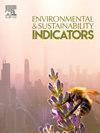Integrating climate indices and land use practices for comprehensive drought monitoring in Syria: Impacts and implications
IF 5.4
Q1 ENVIRONMENTAL SCIENCES
引用次数: 0
Abstract
This study explores the dynamics of drought in Syria, highlighting the importance of integrating multiple indices with land-use practices for effective monitoring and mitigation. The Climatic Research Unit Timeseries (CRU TS) dataset aligns strongly with observed data, demonstrating high Correlation Coefficients (CC) and Nash-Sutcliffe Efficiency (NSE) values for precipitation and temperature. Despite slight discrepancies, the dataset effectively captures Syria's climatic characteristics. An analysis of drought records from 1981 to 2021 indicates an overall trend of increasing aridity, marked by significant drought events in 1999, 2010, 2014, 2017, and 2021. Temperature-based indices underscore the necessity of incorporating temperature data, especially for semi-arid regions. The study evaluates agricultural drought using the Vegetation Health Index (VHI), revealing severe to moderate drought conditions across Syria, with croplands performing slightly better than non-agricultural lands. Correlation analyses of Drought Indices (DIs) demonstrate strong relationships, despite variations in severity classifications. Agricultural Drought Indices (AgrDIs) align more closely with Meteorological Drought Indices (MetDIs), but disparities exist. The intensification of drought has likely exacerbated agricultural challenges, increased socio-economic vulnerabilities, and contributed to unrest and migration, emphasizing the broader geopolitical consequences of climate-induced stress. This underscores the urgent need for further research on future climate risks to water resources, social stability, and economic systems.
求助全文
约1分钟内获得全文
求助全文
来源期刊

Environmental and Sustainability Indicators
Environmental Science-Environmental Science (miscellaneous)
CiteScore
7.80
自引率
2.30%
发文量
49
审稿时长
57 days
 求助内容:
求助内容: 应助结果提醒方式:
应助结果提醒方式:


